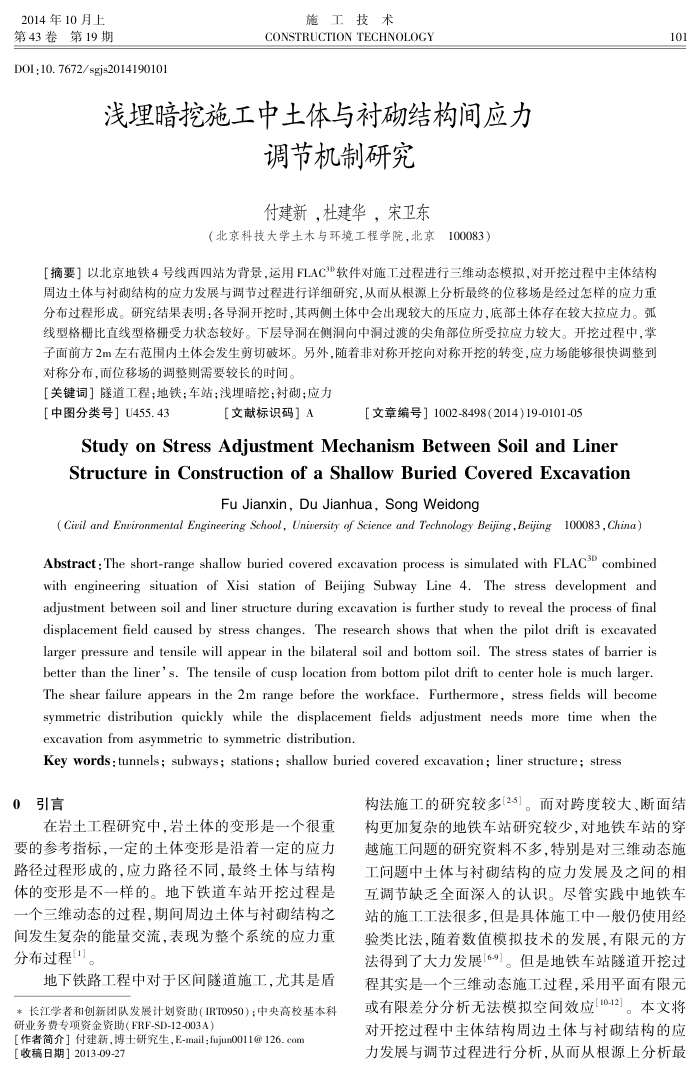浅埋暗挖施工中土体与衬砌结构间应力调节机制研究
内容简介
 2014年10月上第43卷第19期
2014年10月上第43卷第19期DOI:10. 7672/sgjs2014190101
施工技术
CONSTRUCTION TECHNOLOGY
浅埋暗挖施工中土体与衬砌结构间应力
调节机制研究付建新,杜建华,宋卫东
(北京科技大学土木与环境工程学院,北京100083)
【摘要】以北京地铁4号线西四站为背景,运用FLAC3"软件对施工过程进行三维动态模拟,对开挖过程中主体结构周边土体与衬砌结构的应力发展与调节过程进行详细研究,从而从根源上分析最终的位移场是经过怎样的应力重分布过程形成。研究结果表明:各导洞开挖时,其两侧土体中会出现较大的压应力,底部土体存在较大拉应力。弧线型格栅比直线型格栅受力状态较好。下层导洞在侧洞向中润过渡的尖角部位所受拉应力较大。开挖过程中,掌子面前方2m左右范围内土体会发生剪切破坏。另外,随着非对称开挖向对称开挖的转变,应力场能够很快调整到对称分布,而位移场的调整则需要较长的时间。
[关键词]隧道工程;地铁:车站;浅理暗挖:衬础;应力
[中图分类号]U455.43
【文献标识码]A
【文章编号】1002-8498(2014)19-0101-05
StudyonStressAdjustmentMechanismBetweenSoilandLiner Structure in Construction of a Shallow Buried Covered Excavation
Fu Jianxin,Du Jianhua,Song Weidong
(Ciil and Enwironmental Engineering School, Uniwersity of Science and Technology Beijing,Bejing100083, China) Abstract : The short-range shallow buried covered excavation process is simulated with FLAC3 combined with engineering situation of Xisi station of Beijing Subway Line 4. The stress development and adjustment between soil and liner structure during excavation is further study to reveal the process of final displacement field caused by stress changes. The research shows that when the pilot drift is excavated larger pressure and tensile will appear in the bilateral soil and bottom soil. The stress states of barrier is better than the liner's. The tensile of cusp location from bottom pilot drift to center hole is much larger. The shear failure appears in the 2m range before the workface. Furthermore, stress fields will become symmetric distribution quickly while the displacement fields adjustment needs more time when the excavation from asymmetric to symmetric distribution.
Key words: tunnels; subways; stations; shallow buried covered excavation; liner structure; stress
引言 0
在岩土工程研究中,岩土体的变形是一个很重要的参考指标,一定的土体变形是沿着一定的应力路径过程形成的,应力路径不同,最终土体与结构体的变形是不一样的。地下铁道车站开挖过程是一个三维动态的过程,期间周边土体与衬砌结构之间发生复杂的能量交流,表现为整个系统的应力重分布过程(1]。
地下铁路工程中对于区间隧道施工,尤其是盾*长江学者和创新团队发展计划资助(IRT0950);中央高校基本科研业务费专项资金资助(FRF-SD-12-003A)
[作者简介]付建新,博士研究生,E-mail:fujun0011@126.com【收稿日期]2013-09-27
101
构法施工的研究较多[2-5]。而对跨度较大、断面结构更加复杂的地铁车站研究较少,对地铁车站的穿越施工问题的研究资料不多,特别是对三维动态施工问题中土体与衬砌结构的应力发展及之间的相互调节缺乏全面深入的认识。尽管实践中地铁车站的施工工法很多,但是具体施工中一般仍使用经验类比法,随着数值模拟技术的发展,有限元的方法得到了大力发展[69]。但是地铁车站隧道开挖过程其实是一个三维动态施工过程,采用平面有限元或有限差分分析无法模拟空间效应[10-12]。本文将对开挖过程中主体结构周边土体与衬砌结构的应力发展与调节过程进行分析,从而从根源上分析最